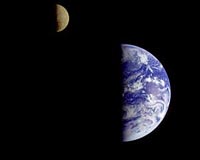 |
Washington DC (SPX) Dec 09, 2009 When the LCROSS rocket stage slammed into Cabeus crater on October 9, creating an impact plume of material that had not seen sunlight for possibly billions of years, it conclusively proved that water ice exists in the dark recesses of the Moon's polar craters. The LCROSS findings delighted William Feldman, a senior scientist at the Tucson-based Planetary Science Institute. "What got me excited is that everything we said is right, which is a nice feeling." In 2001, Feldman was the lead author on a paper in the Journal of Geophysical Research entitled "Evidence for Water Ice Near the Lunar Poles," which was based on neutron spectrometer data that he and his instrument team gathered during NASA's 1998 Lunar Prospector mission. Feldman was working at Los Alamos National Laboratory at the time, and came to PSI in 2006. The paper's conclusions were subsequently confirmed by an extensive series of computer simulations conducted by David Lawrence, of the Johns Hopkins University Applied Physics Laboratory, and his co-workers. This work was published in the Journal of Geophysical Research in 2006. As early as 1961, scientists speculated that water ice could be hidden in the deep recesses of lunar polar craters that never see daylight. These are some of the coldest spots in the solar system, and water from comet and meteorite impacts could freeze and remain for billions of years. Researchers using radar on the 1994 Clementine spacecraft thought they saw signatures for water in their data, but the results were controversial, especially when others, using Earth-based radar, found similar signatures in measurements taken near the Moon's mid-latitude regions, which are exposed to sunlight. Feldman and his team didn't measure water directly, but their data showed evidence for inordinately large amounts of hydrogen in some craters. Other phenomena, such as the solar wind and outgassing, could account for relatively high levels of hydrogen, "but there was a sufficient amount in some of these craters that it would be hard to understand if it came only from the solar wind or through other processes," Feldman said. "So in our paper we didn't call it 'evidence for hydrogen,' but 'evidence for water'." Not everyone agreed, and some controversy surrounded the paper. But, when NASA went looking for water on the Moon with the LCROSS mission, it headed for the Cabeus crater, about 62 miles from the Moon's south pole, that Feldman's Lunar Prospector team had identified as having the maximum hydrogen signature among all the high-latitude craters surveyed. "This is a big, permanently shaded crater," Feldman said. "In fact, you can't even see it from the Earth because it has a rim that hides it. It takes a satellite to see it." "When we converted the hydrogen signal to the amount of water ice in the regolith, we found that it was only about 1.5 percent by weight," Feldman added. "That's the reason the radar researchers really couldn't see it. There aren't large enough deposits of high-grade water ice to create the signal needed to identify ice with radar." So it turns out that Feldman and the Lunar Prospector team showed the first experimental evidence for water on the Moon, which has now been conclusively confirmed by the LCROSS mission. "There's a lot of interest in water on the Moon right now," Feldman said. "And there is more to be learned. The whole story is not in yet." Share This Article With Planet Earth
Related Links Planetary Science Institute Mars News and Information at MarsDaily.com Lunar Dreams and more
 Circumlunar Missions: The Missing Link
Circumlunar Missions: The Missing LinkSydney, Australia (SPX) Dec 03, 2009 Much attention has been focused on plans by various nations to return astronauts to the Moon. At the moment, it doesn't seem that anyone will be landing there for at least another decade. America is revising its original plans for the Orion program, which calls for a return to lunar orbital missions and landings. Some alternatives would see astronauts orbiting the Moon without landing, and ... read more |
|
| The content herein, unless otherwise known to be public domain, are Copyright 1995-2009 - SpaceDaily. AFP and UPI Wire Stories are copyright Agence France-Presse and United Press International. ESA Portal Reports are copyright European Space Agency. All NASA sourced material is public domain. Additional copyrights may apply in whole or part to other bona fide parties. Advertising does not imply endorsement,agreement or approval of any opinions, statements or information provided by SpaceDaily on any Web page published or hosted by SpaceDaily. Privacy Statement |